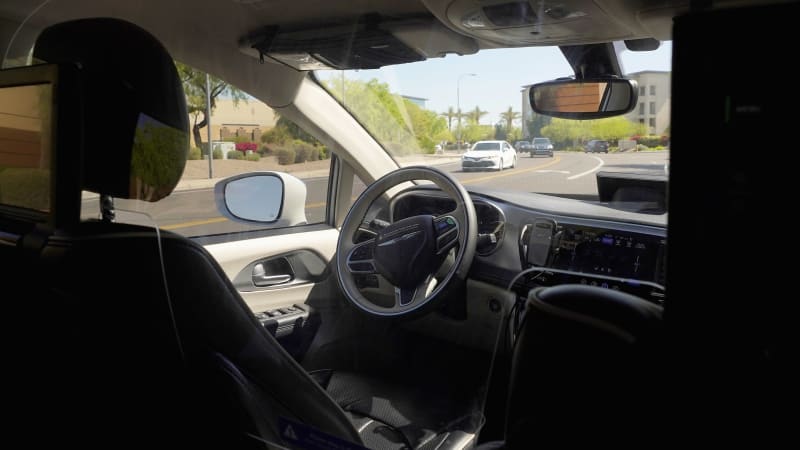CHANDLER, Ariz. – The exasperated shopper paced around and knocked on the windows of a minivan preventing him from leaving his Costco parking lot. He didn’t seem to notice, or he didn’t care that no one was inside.
A colleague and I had called for the Waymo ride – our first in a fully self-driving car – and soon came across a problem: figuring out how to tell him to meet us at the curb.
We finally saw the minivan across the street from the busy parking lot and rushed there. As we drove off, the shopper raised his arm and held out his middle finger.
Welcome to the United States’ first large-scale taxi service without backup drivers, recently launched by Waymo in suburban Phoenix.
An AP photographer and I took it for a ride and discovered some impressive technology. Waymo minivans skillfully adhere to traffic laws and can detect people, vehicles and objects hundreds of feet away.
But amid advancements lurk the challenges developers face as they race to bring autonomous cars to the masses: adapting the machine to human behavior – and making passengers feel comfortable without a person behind the wheel.
“The technology is great, but the experience is not there yet,” said Andrew Maynard, a professor at Arizona State University’s College of Global Futures who studies the social and ethical aspects of self-driving vehicles and other emerging technologies.
Part of Google parent company Alphabet Inc., Waymo is one of several companies testing self-driving vehicles in the US. on the driver’s seat that can take over in difficult situations.
During our rides, the minivans slowed down due to speed bumps and delivered a textbook right-on-red. Most impressive was a careful maneuver under a green light where a woman with a walker stood dangerously close to the corner.
But customers in busy parking lots may find it difficult to locate pick-up locations without drivers being able to call, text, or just look at them.
A Waymo minivan also made an aggressive turn at a green light that we never would have taken. Another didn’t make it to the requested location and dropped us off about a four minute walk.
And seeing the wheel spin itself was, well, spooky.
The company is listening closely to customer feedback and recognizes that it needs to improve passenger pick-up. It also works to create the right expectations for riders and has launched a campaign that provides tips.
Automakers and tech companies were quick to take action in 2018 to put self-driving vehicles into action, but a deadly crash involving an Uber test vehicle in Tempe slowed development.
Only recently did the sector show signs of recovery. Still, most experts believe that widespread use will not begin for about five years, and that autonomous vehicles won’t be in every major city until the end of this decade.
Waymo began offering autonomous rides to a limited number of customers in 2019 during an early testing program in Arizona. Last fall, it opened its ride-hailing program to anyone looking for a ride within the 129-square-mile service area that covers parts of Chandler, Tempe and Mesa.
Our journey started with a welcome from the minivan – an automated voice correctly pronounced my French first name, which people often mangle. A partition separated the empty front seats from the rest of the vehicle, with a sign that read, “Do not touch the steering wheel.”
I felt uncomfortable as the minivan pulled into an intersection and waited for oncoming traffic to pass before turning left. It was as if a ghost were holding the wheel.
My jitters picked up until minutes later, when we made a bold left turn at another green light.
With a number of oncoming cars rushing towards us, the minibus sped up the road across a parking lot. Although we didn’t get close to a crash, the corner scared us.
Waymo later watched the maneuver and said that the cameras and remote sensing technology in a dome on top of the minivan had detected the oncoming cars, knew their speed, and understood that the vehicle could turn safely.
“It was certainly safe in your case,” Saswat Panigrahi, a senior product manager at Waymo, told me.
The company said customers’ comments are being used to fine-tune its autonomous driving systems and user interfaces to address such safety concerns.
The ride-hailing program serves hundreds of passengers a week and offers prices on par with Uber and Lyft. Waymo has 300 to 400 vehicles in Arizona for the program and testing.
We hailed another Waymo minivan to a public library, but were dropped off on a nearby private street instead. Panigrahi believes the minivan may have been diverted due to traffic or a road closure in the area.
From there, we tried to catch a ride back to Costco, but Waymo canceled four travel requests and stopped accepting my credit card as a fraud prevention measure, as several requests were made within minutes.
With my Waymo account locked, I requested a ride from another ride service with a human driver. He talked warmly about his career plans, but when he first picked us up, he carefully tried to pronounce my name.
